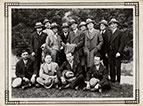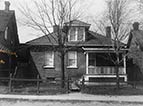Community Life
Oh, there was very little [in the way of social activities]. Just home parties and that's about it. They [would] have an annual picnic every year. Yet they still go on with it where they serve pasta and a lot of Italian food.
Mary Biollo Doyle, daughter of internee John Oliver Doyle, video interview, Columbus Centre Collection
Because of the store and the location, [my father] was also providing quite a bit of service to those other Italians in the community so that they could write home, because they couldn't read and write. My father was a representative of the Bank of Naples initially. And he would make arrangements for the physical paper work because most of them that came over were men. And then once they got established, if they were married with children, they would eventually send for their families. And my father at the time would do a lot of the paper work.
Pat Adamo, granddaughter of enemy aliens Francesco and Filomena Guzzo, video interview, Columbus Centre Collection
I didn't have the leisure time and, you know, the church was our community centre. Absolutely, because we went to church. From there we had the Italian school remember? And from there we had sports. And we had choir. And we had drama. So, it took the place of the community centre. The community centres came in after the church. It was just marvelous. Sacred Heart Church was just, just marvelous. It can never be forgotten really.
Gina Benetti, daughter of enemy aliens Emilio and Angela Sanvido, video interview, Columbus Centre Collection
Migrating Italians often followed relatives or paesani who had already settled in Canada. Building on these relationships, Italian communities were created across Canada. In cities and towns, Little Italies grew – havens from the sometimes hostile Canadian society. In these neighbourhoods, a migrant could speak a specific dialect without having to rely on English, and continue cultural practices established in Italy. In these communities, Italians celebrated holidays, attended church services in Italian, went to Italian restaurants, and shopped in grocery stores that imported Italian foods.
Community Organizations
Italian migrants also formed their own social organizations. The largest was the Order Sons of Italy (OSI) which first appeared in Canada in 1915. Other such groups included the Order of Italian Canadians and the Società di Mutuo Soccorso la Trinacria. For a monthly fee, these organizations provided members with benefits in case of illness or death. The organizations also held regular fundraising events in support of their work.
Italian Canadian Press
Prior to World War II, the Canadian mainstream press did not report news about Italian Canadian communities. As a result, as early as the 1890s, Italian Canadians established their own press. Newspapers such as Montreal’s L’Araldo del Canada and Toronto’s Il Progresso Italo-Canadese reported on events in Italy and in the Italian Canadian communities they served. These were patriotic publications that supported the Italian government but also helped Italian migrants to integrate into Canadian society. Explicitly fascist newspapers began to appear in the 1930s.



